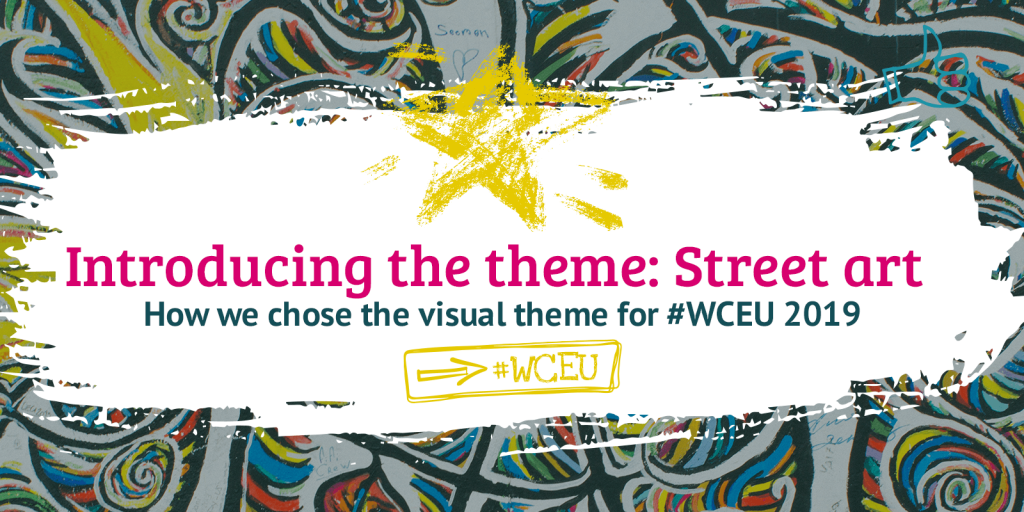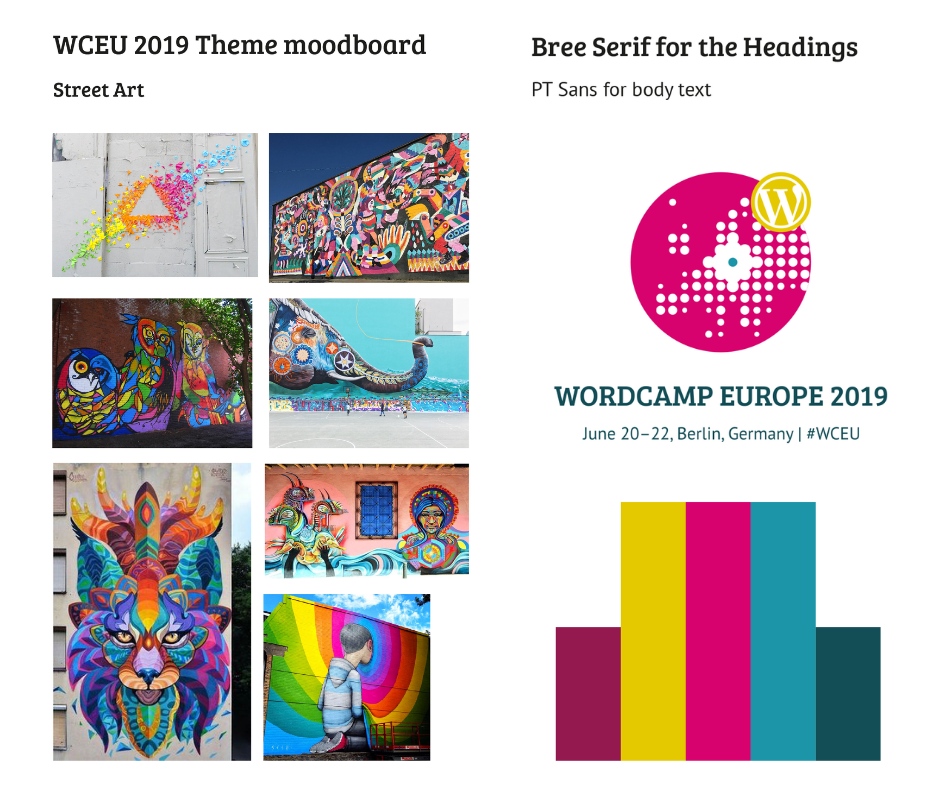
How we chose the visual theme for #WCEU 2019
WordCamp Europe is hosted in a different city in Europe each year, meaning there is an annual opportunity to refresh our take on WCEU, putting a new spin on the established brand.
Each year, the Design Team (a sub-team in the wider WCEU Organising Team) carefully chooses colours, fonts, graphics and a compelling theme that runs through the visual representation of the upcoming year’s edition of WCEU.
For 2019, WCEU is hosted in Berlin, Germany, and our theme is: Street art!
Berlin: Street art capital
Berlin is rich in art and dripping with cultural history. The story of street art in Berlin goes back decades, starting with the Berlin Wall.
The Berlin Wall signified both a physical and ideological separation between the east and west sides of Berlin, and the socio-political setting in the 1960s had an impact on the evolution of the local street art scene. It started with graffiti culture on the west side of the Wall, which became a canvas for creative expression.
Whilst the west side exploded with paintings and colour, the east side remained a blank surface, emphasising the contrast between the two. This changed in 1989 after the fall of the Berlin Wall, when the city united and flourished with art, signifying freedom of expression and shaping the city’s new identity.
In 1990, artists were invited from all over the world to celebrate reunification by painting the empty east side of the Wall.
The Berlin Wall was the birthplace of street art in Berlin, but the movement has evolved into a global attraction. Berlin’s versatile and vibrant street art scene now attracts millions of tourists each year, which has given the city its title of ‘the graffiti Mecca’ or the world’s street art capital.
Choosing the theme
To choose the theme for WCEU 2019, we started by exploring key concepts in relation to WCEU and Berlin, noting artistic composition and culture. The Berlin Wall was a clear reference point, and our attention quickly turned to street art.
We also considered the meaning of WordPress in relation to Berlin. In particular, the importance of Open Source and Berlin’s strong local community. The street art in Berlin represents the same values of creativity and freedom of expression as WordPress, which aims to democratize publishing and give everyone a voice.
Themes that could have been
Before settling on the theme of street art, we delved into a variety of other options. Here are three of our favourite runners up, which came close to making the cut for WCEU 2019.
Bear of Berlin
The bear is Berlin’s heraldic animal and mascot. The symbol of the bear can be found in recognisable landmarks, statues, sculptures and street art all throughout the city.
1989 and the Fall of the Wall
An important theme we discussed was ‘1989’, the year of the fall of the Berlin Wall. In addition to the significant historical relevance of celebrating the 30-year anniversary, we could have imagined revisiting the style of the late 80’s-early 90’s.
Carnival of Cultures
Another concept that was considered was carnival, specifically relating to the Carnival of Cultures, or Karneval der Kulturen, a popular four-day festival consisting of music and theatrical performances.
How the street art theme evolved
The theme of street art was explored firstly with visual research by collecting photos and inspiration online, and further with anthropological research into the meaning and significance of street art for the people who live and work in Berlin.
After deciding on the theme, we chose a colour palette and font. Street art as a theme offers vast opportunities for possible declinations, styles, and applications, so the design process so far has been extremely creative.

Colours
When deciding on colours for the theme, it was natural to start looking for colours that are popular within street art. We also wanted 2019’s edition to stand out from other years.
We experimented with a lot of different colour pallets. We agreed that the colour palette must:
- Appeal to a broad target group
- Execute the same power online as offline
- Contribute to the theme
- Be appropriate for swag giveaways, such as t-shirts
- Be considerate in terms of accessibility issues, such as colour-blindness
Consideration was given to previous WCEU colour schemes to avoid similarity, then colour palettes were shared and assessed amongst the Design Team, before the final choices were agreed upon.
Font
We chose our fonts in the same manner as we chose the colours. We experimented with many different options, taking into account how well Headings and Body Text worked together for different fonts.
We considered how our communication platforms would be diverse: publishing online using social media, posting long-form text in our blog, offline with small print in the event booklet, and large print for event signage.
We knew our font choice would need to be consistent throughout, so we needed a typeface that would work no matter what, whilst avoiding a boring choice. We agreed that the font must:
- Fit or enhance the theme
- Be easily readable both online and offline
- Be accessible for all
- Radiate its own identity, independent of other WCEUs
As with the colour selection, font preferences were chosen by the Design Team, using options that are freely available on Google Fonts, and these were discussed and assessed. Based on our decision to diversify the font choice from previous editions of WCEU whilst providing an identifiable look and warm feel, we agreed on the choice of Serif.
Find your favourite pieces
When you visit Berlin for WCEU 2019, we’re sure you’ll want to see some of the world-famous street art for yourself. We’ve picked out some of the most famous street art pieces and collections:
- East Side Gallery: an open-air gallery and heritage-protected landmark consisting of murals painted directly on remnants of the Berlin Wall.
- Urban Nation Bülowstraße: more than your average museum, this international institution is a centre for urban contemporary art, creative projects and social exchange.
- Korkmännchen: also known as Street Yogis, are (barely) hand-sized figures made of kebab skewers and bottle corks that sit on top of street signs in Berlin.
- The Yellow Fists: a sign of rebellion that you’ll see splattered around the entire city, even in places that are out of reach or where you wouldn’t expect.
- Astronaut Cosmonaut: an iconic mural painting that has been admired for over a decade. As one of the most pictured murals in Berlin, this floating astronaut has become legendary.
Whilst street art has history in Berlin, it has global and timeless relevance. With an established set of recognisable characteristics, the theme of street art invites you to bring your own explorations and interpretations too.
Thank you, street artists
Our chosen theme is prominent in our web design and throughout our graphics. We spotlight many pieces of street art, graffiti and murals from the streets of Berlin and we would like to thank the talented artists that created them. We admire their work.
In particular, we’d like to credit the German artist Jadore Tong (also known as S.Y.R.U.S.) who created the mural of an elephant playing with a balloon that resembles a globe. We love this street art so much that we chose to use a photograph of this piece as the main image on our homepage.
*All WCEU tickets sold out on 18 May 2019. Thank you, and see you in Berlin! 🙂